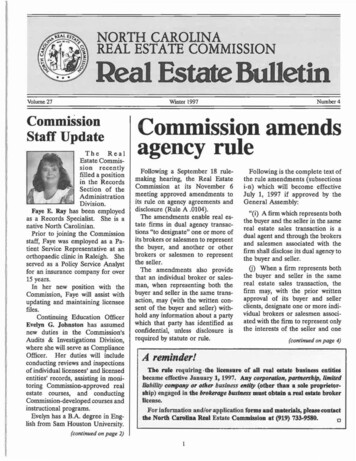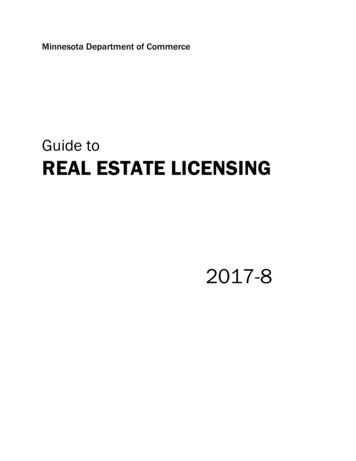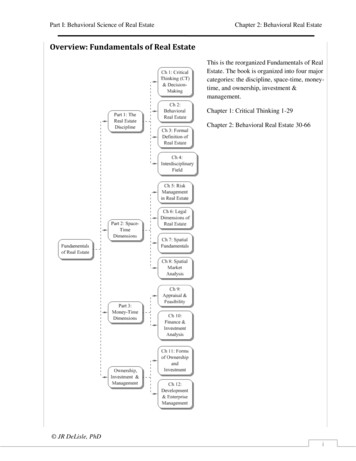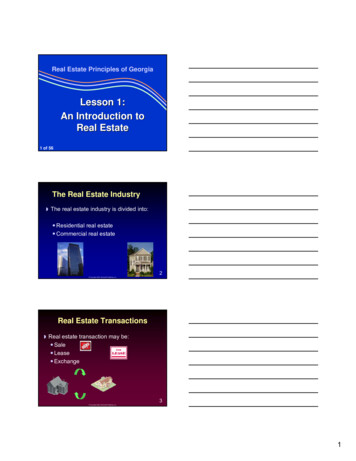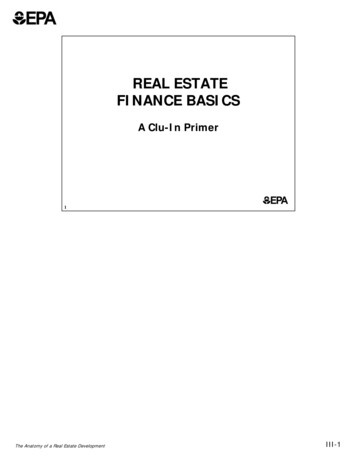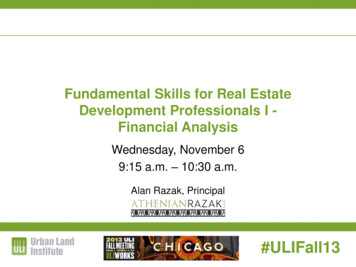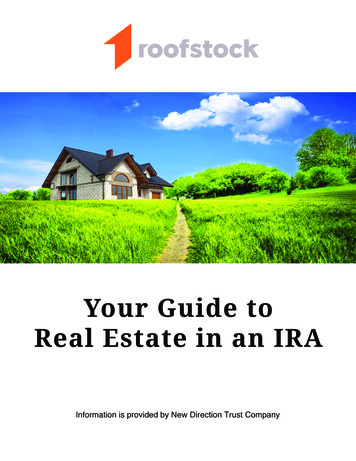
Transcription
Your Guide toReal Estate in an IRAInformation is provided by New Direction Trust Company
ContentsINTRODUCTION 03TAX-DEFERRED/TAX-FREE PLANS ELIGIBLE FOR SELF-DIRECTION 04WHAT ARE THE BENEFITS OF HAVING REAL ESTATE IN AN IRA? 04IMPORTANT THINGS TO KNOW 04DISQUALIFIED PERSONS AND PROHIBITED TRANSACTIONS 05POSSIBLE STRUCTURES FOR YOUR IRA TO PARTICIPATE IN REAL 06ESTATE USING AN LLC IN YOUR PURCHASE STRUCTURE 06LEVERAGING REAL ESTATE IN AN IRA 07PROPERTY MANAGEMENT OF RENTAL REAL ESTATE IN AN IRA 07STEP-BY-STEP INSTRUCTIONS 08TIMETABLE 09CASH PLANNING WITHIN THE IRA 09REAL ESTATE DISTRIBUTION STRATEGY CONSIDERATIONS 09REAL ESTATE IRA FREQUENTLY ASKED QUESTIONS 10
IntroductionThe IRS allows an IRA, Individual 401(k), or HSA to acquire real estate as anasset without penalty and while keeping the tax benefits associated with thataccount type.An IRA can purchase any type of real estate, including residential,commercial, raw land, agricultural, and more. The IRA can buy the propertyoutright, meaning the IRA is the title holder. If the IRA does not have the fullpurchase price, the IRA can partner with a person, company/entity, or anotherIRA. It can also secure a non-recourse loan (see below) to buy real estate.Real estate in an IRA provides the opportunity to generate income fromrent, appreciation, fixing and flipping, and more.It has been possible to participate in real estate as an asset since the inceptionof IRAs. What has not always been easy is finding an IRA provider who waswilling to service this type of investment. The IRS requires an authorized IRAprovider for all IRAs. Not all IRA providers handle real estate, but New DirectionTrust Company does.You, the IRA holder, along with your financial professional, select theproperty and negotiate the terms. New Direction Trust Company makessure that the paperwork substantiates that the asset is part of your IRA and,thus, deserves the tax benefits associated with the account type.This report will give you detailed information on Self-Directed IRA realestate investing.3
Tax-deferred/Tax-free PlansEligible for Self-Direction1. Traditional IRA4. SIMPLE IRA2. Roth IRA5. 401(k) Plan3. SEP IRA6. HSA – Health Savings AccountsWhat are the Benefits of HavingReal Estate in an IRA? Real Estate is a tangible asset and one that you understand. Investment properties can potentially yield rental return as well as marketappreciation. You have strategic control over the properties that your retirement accountowns. You can buy, sell, and exchange properties without tax consequence.Important Things to Know An IRA is its own financial and legal entity, separate from your personal finances. As a separate legal entity, your IRA has its own name:New Direction Trust Company FBO client name, IRA The IRA is the owner of the real estate, not the IRA holder. Therefore, purchase andmaintenance costs are paid by the IRA and all income (e.g. rent) goes back to theIRA. All legal documents (offer, closing documents, leases, etc.) related to an IRA-owned asset must be in the name of the IRA, not your personal name. Documents associated with your IRA’s real estate acquisition need to be signed byNew Direction Trust Company (as the custodian for that account) to be legal.4
Disqualified Persons andProhibited TransactionsAll IRAs have a list of people who are disqualified from having certain interactionswith that account. Below is a graphic that delineates which persons are disqualified.Keep in mind that any entity that is owned or controlled by a Disqualified Person isalso disqualified.Non-Disqualified Persons include: siblings, aunts, uncles, cousins, father-in-law, mother-in-law, etc. Neither the IRA holder nor any other Disqualified Person to that IRA may live in oruse the property. Disqualified Persons cannot work on the property, for free or for pay.“Sweat equity” is not allowed. Any remodeling, repair, improvement, and evenmaintenance must be performed by a non-disqualified person or entity. Your IRA cannot purchase a property from you or any Disqualified Person, nor canyour IRA sell a property to a disqualified person. Neither you nor a Disqualified Person can guarantee a loan for an IRA property. Disqualified Persons are not allowed to be paid by the IRA.5
Possible Structures for your IRAto Participate in Real EstateHold title to Real Estate - A real estate contract is written between the IRA and theseller. Funds from the IRA are sent to closing for the purchase and the IRA takes titleto the property directly.Tenants-in-Common with a partner entity - This is one of the ways an IRA canparticipate in a real estate asset without necessarily having the entire purchase price.The partner can be a person (even a disqualified person), an IRA, a company, or otherentity.Private Equity in an entity (like an LLC, LP, C-corp., etc.) that then invests in realestate - The asset in your IRA in this case is shares of a private company or percentage ownership in that company.Loan money to a borrower who uses Real Estate as collateral - You can think ofyour IRA as a private lender. Your IRA can lend money to non-disqualified personsand secure the note with real estate holdings and/or other assets if you like. You andthe borrower decide on the term, collateral, and the rate.Using an LLC in your PurchaseStructureYour IRA can use an LLC or entity in its ownership structure, but it is not required. AnIRA can have direct ownership in a real estate asset, or it can participate in an entitythat then owns real estate. LLCs are commonly used for real estate investments outside of an IRA to achieve a level of liability protection. So, it is common for investorsto think that they automatically need this same setup in their IRA.The account holder decides what the structure of the investment will be. The legalboundary inherent in an IRA may or may not satisfy the IRA holder’s risk tolerance.And, of course, not all LLCs are created equally when it comes to liability protection.Strategies to mitigate risk certainly include liability insurance purchased by the IRAfor its asset(s) as well as having the IRA own an LLC which owns the property.6
Leveraging Real Estate in an IRAAn IRA may secure a loan to purchase property. According to the IRS, it must be anon-recourse loan (the lender is acknowledging, in the case of default, their onlyavenue for remuneration is the property itself ). Not all lending institutions and banksoffer these types of loans, but several do exist. Also, a non-recourse loan can comefrom a private lender.When an IRA purchases real estate using a non-recourse loan, the debt financedportion of the property’s profits may be subject to Unrelated Business Income Tax(UBIT). Similarly, if an IRA-owned property is sold while a percentage of ownershipis still debt financed, the profits derived from the debt financed percentage may besubject to UBIT. UBIT is calculated on a form 990-T and is paid by the IRA. It does notaffect the IRA holder’s personal taxes.Property Management of RentalReal Estate in an IRAAfter your IRA has successfully purchased real estate, the IRA holder is the decisionmaker for that property. That may include the hiring of a property manager (or othernon-disqualified person or entity) to handle the day-to-day cash flow and operations, or you may choose to work directly with New Direction Trust Company to payvendors and other bills out of your account.Income generated by the IRA-owned real estate must go back into the IRA. Rentchecks are made out to the IRA (or the management company if there is one), notthe IRA holder.As the IRA holder, you have the ability to choose the vendors for your IRA-ownedproperty. Maintenance and improvements cannot be performed by the IRA holderor any disqualified person.You may not pay for any property related expenses with your personal funds on behalf of the IRA. All expenses are paid from the IRA.7
Step-by-Step InstructionsStep 1 – Open your self-directed IRA and fund it with a rollover, transfer, and/orcontribution.Step 2 – Work with your real estate agent to find a property. Make sure the offer/contract reflects the IRA as the buyer. (Purchase contracts inthe name of disqualified persons cannot be assigned to the IRA via an assignment,amendment, etc.) Do NOT put the contract in your name or personally pay the earnest money.Please complete all investment documents using the following guidelines: BUYER / OWNER NAME:New Direction Trust Company FBO John A. Smith IRA-ORNew Direction Trust Company FBO Account No. 12345678-ORNew Direction Trust Company FBO John A Smith, IRA, Account No. 12345678If you partner your IRA with a disqualified person/IRA/entity, you must establish thepercentage of ownership at the beginning of the investment. Those percentages willbe used to divide up the incoming revenue and pay all expenses, including earnestmoney. For example, the vesting would be shown as follows, assuming a 60/40 split (thepercentages can be anything from 50/50 to 99/1):New Direction Trust Company FBO John A. Smith IRA, as to an undivided 60%interest, and John A. Smith, as to an undivided 40% interest-ORNew Direction Trust Company FBO John A. Smith IRA, as to an undivided 60% interest,and New Direction Trust Company FBO Joseph B. Smith IRA, as to an undivided 40% interestEarnest money must be paid from the IRA or by a non-disqualified person whomay then be reimbursed by the IRA.8
TimetableCash Planning Within the IRAYour IRA is responsible for all expenses related to your investments, includingany emergency expenses like a new roof or new appliances. Having a plan forcontingencies and/or maintaining reserves of cash in your IRA account can make thisan easy process.Rental income from the IRA-owned property, annual contributions to the account,and rollovers/transfers from other plans may be used to pay expenses.Real Estate Distribution StrategyConsiderations An IRA holder may begin taking distributions from their plan at 59.5 years of agewithout penalty. Distributions made prior to age 59.5 will result in an early distribution penalty of10%. A distribution can be taken in cash or in-kind. With a cash distribution, the IRA holder liquidates real estate asset(s) within theaccount and then requests a “cash” distribution (in the form of a check or wire)from the account. With an in-kind distribution, the asset itself (or some percentage of the asset) isdistributed to the account holder. If the distribution is being taken from a Traditional IRA, tax is due on the value ofthe distribution, cash or in-kind. Similar to the way that an account holder can distribute a percentage of the cashin their IRA over a number of years to spread out the tax burden, an in-kinddistribution can take place over a number of years. Valuation prior to distribution of a real estate asset generally needs to be in theform of a formal appraisal.9
Real Estate IRA Frequently AskedQuestionsCan I buy real estate in my Retirement Plan?Yes! The IRS has had this question so many times they answer it directly on their website(www.irs.gov). In their retirement Q & A section they say “IRA law does not prohibitinvesting in real estate but trustees are not required to offer real estate as an option”.Therefore, to invest in real estate your IRA custodian must allow it. New Direction TrustCompany handles real estate and many more alternative assets.Why haven’t I heard about real estate investment in IRAs before?Retirement investing has been dominated by the securities industry since 1974 but realestate has always been available to IRAs. The opportunity to invest IRA funds directly in realestate is an option that many people are just learning about.I have a 401(k). Can I invest that in real estate?Your 401(k) plan may, at your direction, be invested in real estate if the investmentprovisions of the plan permit it. The employer establishes the plan for the benefit of theemployees, and that employer will have language incorporated in the plan document whichstates what investment options are available to the employee. If you have a 401(k) from anemployer for whom you no longer work, those funds can be rolled over to a traditional IRAwith no tax consequence. From there, you can invest in real estate.What about borrowing? Can my IRA get a mortgage?Yes, the IRS requires that the loan be a non-recourse loan. The lender can be a bank or aprivate lender. IRA non-recourse loans tend to require a higher down payment than thosefor personally guaranteed loans.What are the restrictions for the purchase?The primary requirement is that the purchase be for investment purposes only. The IRAowner, certain family members, and plan fiduciaries cannot use the property while the IRAowns it. Your IRA is not allowed to buy property you already own personally.What can I invest my IRA and qualified plans in?There are two broad asset categories that are not allowed: life insurance and collectables.Beyond that, the IRS does not approve any specific investments. Usually limitations on assettypes are a result of the IRA provider’s business model, not IRS regulations.What are “alternative” investments?“Alternative” investments are assets, such as real estate, that are not publicly tradedsecurities. Almost anything you can invest in outside of your IRA can be purchased insideyour IRA.Do I need an LLC to purchase real estate with my IRA?An LLC may be used to purchase real estate, but it is not required. See above.Where do I find an investment property?It’s up to you and your real estate agent to find the property. There are no limitations orrestrictions other than the property cannot be something you or any disqualified personcurrently own.10
Do I need to use a special broker and title company?No special broker or title company are required, you can use the same ones you used to buyyour current home.Can I repair the property myself?You may not personally do any work on the property and neither can any other disqualifiedpersons or any company you or they own. Work can be done by anyone else and you stillhave control over what you want them to do. Basically, you can’t personally put the paint onthe walls but you can choose the painter and the paint.Can I partner my IRA with my personal funds? Who else can I partner with?If you cannot afford the investment property you are interested in you have many options.One option is to partner with yourself. For example your IRA can own 50% and you canpersonally own 50% (note: even if you personally own 99% of the property you are stillprohibited from living in it or using the property.) You may also partner with someone else’spersonal or IRA funds, the disqualified persons rule does not apply here so you may partnerwith your spouse, parent, child, friend, or whomever. There is no limit to how many peopleyou can partner with.How are the expenses paid on an IRA-owned property handled?Expenses are to be paid directly from the IRA. If the IRA owns 100% of the property it isresponsible for 100% of the expenses. If your IRA is a partner, it is responsible for its portionof the expenses. Because the IRA must pay the expenses it is important to make sure thereare sufficient funds in the IRA to cover the expenses. When purchasing the property don’tforget to take expenses into account.Where does rent income go?Rental income from the investment goes directly into the IRA.How long must my IRA own a property before selling it?There are no time restrictions or limitations on buying or selling a property.Do I have to pay capital gains taxes if I sell the property?Because the property is owned within a tax deferred (Traditional IRA) or tax free (ROTH IRA)plan, no capital gains taxes need to be paid as long as there is no outstanding debt leveragefor 12 months prior to the sale. If there is outstanding debt leverage, UBIT may apply to thepercentage of that leverage.Can I take property as a distribution and then live in it?Yes, after you reach 59.5 years of age you may choose to take the property as a distributionfrom your IRA. Once the property is 100% distributed, it is in your possession and you arefree to use the property as you wish.How long does it take to purchase a property?See timetable above.What exactly is UBIT?Unrelated Business Income Tax applies to debt financed property in IRAs and also applies tooperating income received from companies owned by IRAs and qualified plans. Typically thedebt financed income is taxable under UBIT rules for the percentage of property that is debtfinanced.11
IRA can have direct ownership in a real estate asset, or it can participate in an entity that then owns real estate. LLCs are commonly used for real estate investments out-side of an IRA to achieve a level of liability protection. So, it is common for investors to think that they automatically need this s

